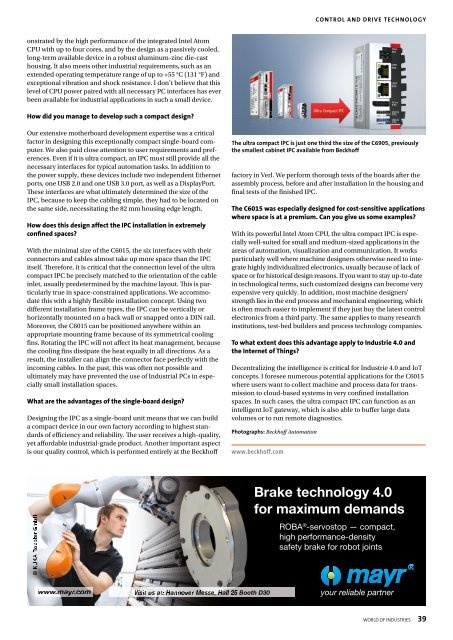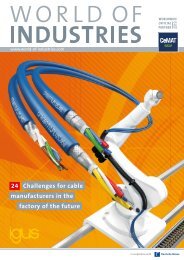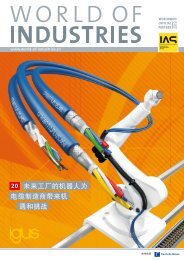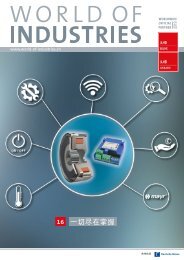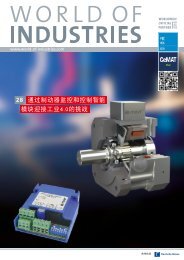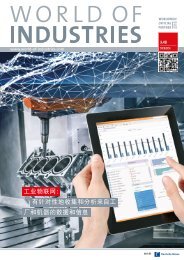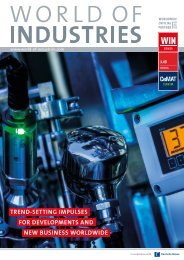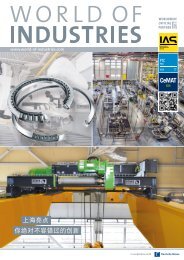world of industries 3/2017 (EN)
world of industries 3/2017 (EN)
world of industries 3/2017 (EN)
- TAGS
- world
- industries
Create successful ePaper yourself
Turn your PDF publications into a flip-book with our unique Google optimized e-Paper software.
CONTROL AND DRIVE TECHNOLOGY<br />
onstrated by the high performance <strong>of</strong> the integrated Intel Atom<br />
CPU with up to four cores, and by the design as a passively cooled,<br />
long-term available device in a robust aluminum-zinc die-cast<br />
housing. It also meets other industrial requirements, such as an<br />
extended operating temperature range <strong>of</strong> up to +55 °C (131 °F) and<br />
exceptional vibration and shock resistance. I don’t believe that this<br />
level <strong>of</strong> CPU power paired with all necessary PC interfaces has ever<br />
been available for industrial applications in such a small device.<br />
How did you manage to develop such a compact design?<br />
Our extensive motherboard development expertise was a critical<br />
factor in designing this exceptionally compact single-board computer.<br />
We also paid close attention to user requirements and preferences.<br />
Even if it is ultra compact, an IPC must still provide all the<br />
necessary interfaces for typical automation tasks. In addition to<br />
the power supply, these devices include two independent Ethernet<br />
ports, one USB 2.0 and one USB 3.0 port, as well as a DisplayPort.<br />
These interfaces are what ultimately determined the size <strong>of</strong> the<br />
IPC, because to keep the cabling simple, they had to be located on<br />
the same side, necessitating the 82 mm housing edge length.<br />
How does this design affect the IPC installation in extremely<br />
confined spaces?<br />
With the minimal size <strong>of</strong> the C6015, the six interfaces with their<br />
connectors and cables almost take up more space than the IPC<br />
itself. Therefore, it is critical that the connection level <strong>of</strong> the ultra<br />
compact IPC be precisely matched to the orientation <strong>of</strong> the cable<br />
inlet, usually predetermined by the machine layout. This is particularly<br />
true in space-constrained applications. We accommodate<br />
this with a highly flexible installation concept. Using two<br />
different installation frame types, the IPC can be vertically or<br />
horizontally mounted on a back wall or snapped onto a DIN rail.<br />
Moreover, the C6015 can be positioned anywhere within an<br />
appropriate mounting frame because <strong>of</strong> its symmetrical cooling<br />
fins. Rotating the IPC will not affect its heat management, because<br />
the cooling fins dissipate the heat equally in all directions. As a<br />
result, the installer can align the connector face perfectly with the<br />
incoming cables. In the past, this was <strong>of</strong>ten not possible and<br />
ultimately may have prevented the use <strong>of</strong> Industrial PCs in especially<br />
small installation spaces.<br />
What are the advantages <strong>of</strong> the single-board design?<br />
Designing the IPC as a single-board unit means that we can build<br />
a compact device in our own factory according to highest standards<br />
<strong>of</strong> efficiency and reliability. The user receives a high-quality,<br />
yet affordable industrial-grade product. Another important aspect<br />
is our quality control, which is performed entirely at the Beckh<strong>of</strong>f<br />
The ultra compact IPC is just one third the size <strong>of</strong> the C6905, previously<br />
the smallest cabinet IPC available from Beckh<strong>of</strong>f<br />
factory in Verl. We perform thorough tests <strong>of</strong> the boards after the<br />
assembly process, before and after installation in the housing and<br />
final tests <strong>of</strong> the finished IPC.<br />
The C6015 was especially designed for cost-sensitive applications<br />
where space is at a premium. Can you give us some examples?<br />
With its powerful Intel Atom CPU, the ultra compact IPC is especially<br />
well-suited for small and medium-sized applications in the<br />
areas <strong>of</strong> automation, visualization and communication. It works<br />
particularly well where machine designers otherwise need to integrate<br />
highly individualized electronics, usually because <strong>of</strong> lack <strong>of</strong><br />
space or for historical design reasons. If you want to stay up-to-date<br />
in technological terms, such customized designs can become very<br />
expensive very quickly. In addition, most machine designers’<br />
strength lies in the end process and mechanical engineering, which<br />
is <strong>of</strong>ten much easier to implement if they just buy the latest control<br />
electronics from a third party. The same applies to many research<br />
institutions, test-bed builders and process technology companies.<br />
To what extent does this advantage apply to Industrie 4.0 and<br />
the Internet <strong>of</strong> Things?<br />
Decentralizing the intelligence is critical for Industrie 4.0 and IoT<br />
concepts. I foresee numerous potential applications for the C6015<br />
where users want to collect machine and process data for transmission<br />
to cloud-based systems in very confined installation<br />
spaces. In such cases, the ultra compact IPC can function as an<br />
intelligent IoT gateway, which is also able to buffer large data<br />
volumes or to run remote diagnostics.<br />
Photographs: Beckh<strong>of</strong>f Automation<br />
www.beckh<strong>of</strong>f.com<br />
© KUKA KA Roboter GmbH<br />
Brake technology 4.0<br />
for maximum demands<br />
ROBA ® -servostop —compact,<br />
high performance-density<br />
safety brake for robot joints<br />
www.mayr.com<br />
Visit us at: Hannover Messe, Hall 25 Booth D30<br />
your reliable partner<br />
MAYR.indd 1 15.03.<strong>2017</strong> 09:06:26<br />
WORLD OF INDUSTRIES 39


